
Therapist Breaks Down How Birth Order Among Siblings May Have Quite An Impact On Their Personalities And A Lot Of People Think It’s Spot-On
Psychology is such a fascinating science, because you can learn so many new things about yourself: the reasons behind your behavior, your reactions to certain things, or why you prefer some things over others. For example, did you know that the order in which you were born may impact your personality?
TikTok user @risethriverepeat created a TikTok series that went viral describing what personality traits are common for someone who is the youngest, oldest, middle child, and others. A lot of people in the comments were saying that those descriptions were very accurate, so maybe you too can relate.
More info: TikTok
TikTok user explains Adler’s birth order theory, which suggests that children can develop different personalities based on which order they were born in
Image credits: risethriverepeat
TikTok user @risethriverepeat’s real name is Tristan Collazo and he is a licensed resident in counselling. On TikTok, he talks about mental health, various disorders, traumas, and other things that are related to psychology.
One of his series really blew up: the first part got 7.8 million views and more than 800k likes. In this series, Tristan talks about Adler’s concept of birth order. The theory was developed by Alfred Adler, an Austrian psychiatrist in the first half of the 20th century. He claimed that birth order affects a child‘s personality and Tristan is explaining what Adler‘s observations were.
Oldest children tend to be the responsible ones, the perfectionists, and the helpers
Image credits: risethriverepeat
Tristan starts this series by explaining what is common to the oldest children in families. Parents have high expectations from their firstborns, but once they have a sibling, they have to adapt to not being the only child anymore. This conditions the oldest children to be perfectionists, people pleasers, authoritative but very helpful and responsible.
To some, this concept might seem outdated, and a curious commentator asked if Adlerian therapy was still practiced. Tristan answered that therapists still use the concepts because it’s still valuable information, just every family and every person is different, so they can’t be applied perfectly.
In another video, he touches on if this theory should be discarded, as there are so many things that go into one’s personality, such as socioeconomic status, gender roles, and social influences, but the therapist firmly believes that it shouldn’t be discarded as it explains some of the tendencies.
The second child has a competitive nature and is always improving their skills
Image credits: risethriverepeat
In the second part, Tristan discussed the second child. They learn how to share quickly and from the start, they have divided parent attention. The older sibling is someone they look up to, although there is also competition and the second child wants to be as good or better than them, which is why they can be better adjusted in life. Like the oldest child, they are people pleasers, but rebellious. They may have a competitive spirit, always learning something new, improving themselves.
Image credits: risethriverepeat
Image credits: risethriverepeat
Middle children can have very varying personalities: from frustrated to cooperative
Image credits: risethriverepeat
As mentioned, the first video in the series got 7.8 million views and the second got nearly 3 million views, so Tristan continued by explaining what personality traits middle children tend to have. The middle child can become resentful or frustrated because they are no longer the youngest. The therapist explains that it’s not easy for a middle child to please parents as much when there is a younger and an older sibling. Also, it’s different if it’s a smaller or a bigger family. Middle children in small families tend to be more frustrated, but in bigger families, they can be more cooperative.
The traits of a middle child aren’t so one-sided: they can feel that the world is unfair, feel like they’re not getting enough love and be impatient; on the other hand, middle children can be even-tempered, adaptable, and able to compromise.
Image credits: risethriverepeat
The youngest children are the babies of the family, but can be competitive
Image credits: risethriverepeat
In his next video in the series, the therapist continues with the personality traits the youngest child in the family tends to have. The youngest child doesn’t have to compete with a younger sibling, which would require a lot of attention from the parents, especially in the first years. They are the ones receiving more attention from the parents as the older children are more independent, so the youngest is always treated like the baby of the family.
They are more likely to be outgoing and attention seeking, but they can feel inferior to their older siblings and feel the need to be competitive. They may behave as the only child and be very dependent on other people.
Image credits: risethriverepeat
Image credits: risethriverepeat
One of the twins can become a leader and the other may have identity issues
Image credits: risethriverepeat
Having a twin must have some sort of an influence on one’s personality, right? Tristan explains that often there is a ‘stronger’ and ‘weaker’ twin. Parents may identify one of the twins as the older one, despite there being nearly no age difference at all. So the younger one may feel the need to compete with the other twin. Also, if one becomes the leader, the other may deal with identity issues.
The only child may have trouble sharing, but appear more mature because they spend more time with adults
Image credits: risethriverepeat
People were really waiting for this one, requesting it in almost every previous video’s comments—the only child. The only child doesn’t have to compete for parents’ attention. They may be hyper-dependent if the parents are overprotective. Because they are the only ones getting everything from their parents, they can have trouble sharing and be more upset when things don’t go their way. But they can appear more mature, because in the family, they interact mostly with their parents and not other children. They can develop a sense of self-entitlement and have more confidence.
The only girl among brothers can become either overly feminine or a tomboy
Image credits: risethriverepeat
People in the comments were pointing out that some of the concepts, for example, middle child, don’t apply to them because they are the only girl or the only boy among children in their family. So in the next video, the therapist goes on to explain that the only sister among brothers may have been overprotected by her brothers. They may have not let her date, because no one seemed good enough. These circumstances can lead to the girl becoming overly feminine or a tomboy.
The only boy among sisters can become the head of the family or embrace their feminine side more
Image credits: risethriverepeat
The opposite circumstances, a brother surrounded by sisters, can lead to two outcomes as well: the boy can become the head of the home or embrace their feminine side more.
It’s more the situation that a person is born into than the order of birth
@risethriverepeatPsychological birth order ##alfredadler ##birthorder ##psychology ##fyp ##mentalheath ##therapy ##therapist ##counseling ♬ empty crown – YAS
Video credits: risethriverepeat
Looking at these descriptions, you can see that it is not just the order in which a person is born that affects them, but the general circumstances. This is what Tristan Collazo says: “This concept states that it’s not merely the order in which you were born, but the situation in which you were born and the way in which you interpret it. There is a lot that is similar for children born in the same home; however, the psychological situation of each child is unique and differs from the others. In other words, no two children are born into the same family. Individuals can identify with more than one birth order category, as all first-born children have been only children, along with middle children having once been the youngest child.”
Many people were saying that they can relate to the descriptions
Have you ever heard of this distinction and different personality traits according to someone’s birth order? Do you find that these descriptions apply to you? Let us know in the comments!
187Kviews
Share on FacebookFar too generalist. Try having a toxic narcissist as an older sibling.
Sympathy... I have a toxic narcissist as a younger sibling. They're not easy to cope with, are they?
Load More Replies...This has no scientific backing, and it is mostly random talk. Truism in a form that is also employed by astrologers. Which person, who is a first child, would not tend to agree that he or she is a "people pleaser"? And if that not, maybe "authoritative"? Do not trust people on TikTok who make wild claims even if they sound true, if they fail to provide an educated bibliography to back up what they say.
It depends what you mean by scientific backing. These ideas are very well-known. They date back fron the early XXth century. Have a look at Alfred Adler, eg. on Wikipedia.
Load More Replies...Only child here. Everyone is always so jealous, but it gets lonely sometimes. :(
Very true, all my friends would say how lucky I was being an only child, more attention from parents and more birthday/Christmas presents, but none of them realize how lonely it is. I was a surprise baby my mum had at 41 so there was no chance of any siblings. There's a lot of pressure on being the only child, your the one that has to carry on the family line.
Load More Replies...... are we all discovering the significance of birth order for the first time? It's a generalization that some people related to. It's not new and it doesn't apply to a lot of people.
This did not ring true for me. I have two older sisters and a younger brother. The oldest has been a bully our entire life, to each of us. The second is completely aloof and distant, detached, shows little to no affection. Me, I am the "odd" one of the three sisters who lived my life completely different then my older sisters. I didn't follow my mothers teachings regarding cooking and traditions as if they were gospel like my sisters do. They both started having kids at 18 and 19, a whole slew of them too. I traveled, explored life, tried different careers and did not have a child until I was 42. My younger brother is angry and misanthropic, and absolutely hates our eldest sister... he hates the world at large. No, I think blueprinting family dynamics is futile.
Always puzzled why something thats been around for ages is suddenly viral and amazing and gobsmacks Twitter/The Internet/Whatever just because someone brings it up. This theory has been around since 1937. Many. many books have been written on it. I remember seeing party type books with quizzes in them to ask people and see if it applied (it doesn't always, at all) This Theory was also soundly debunked in 2015 if not earlier. Also, again, at the risk of being boring, but again - really don't get the point of these articles where there are 19 frames of The Same Face staring into the camera, complete with wardrobe changes, with a line of text under it. Give the person credit, them type up the point of it.
Thank you for noting that it's solidly debunked (Rohrer et al., PNAS, to be precise, as I noted somewhere above).
Load More Replies...I've always disliked these as they don't account for families in today's day & age. My parents divorced when I was there. Remarried shortly after that. Each step parent has children - I have a half sibling. I spent time at both houses. In one home I was the middle child. In the other I was the youngest- however- all siblings moved out of that home by the time I was 12. SO- where do I fit in?
Utter BS without any scientific evidence. But what else do you expect from a tiktok post? Might just as well look for facts on info wars or breitbart.
As an only child I always hated this idea other people would have that only children don't share. I always shared, but saw many greedy kids with siblings who never shared at all, because they had to compete for anything with their siblings.
Same here! I loved to share things with others and show them my cool toys and other stuff as a kid.
Load More Replies...Birth order is stupid and wayyy too general. I read an article about this, and one line was "If someone asked you 'why are you the way you are?' would you say, 'oh, because I'm the youngest in my family?'" You wouldn't. Not every family is the same.
Hey an intern read the part of his text book in intro to counseling theory about north order and thinks he hit s**t by quoting it on tik tok. His sup sees this and it actually could jeopardize his placement since appears to be filming in an office at work... be smarter young intern. Sincerely a licensed therapist of 15 years
Oldest of three and the only boy... Shy at heart but very outgoing when in my element. Very protective over my younger sisters. Not that no one was good enough... just that I'd beat the hell out of any asshole who would disrespect my girls. At 63, I'm the same way over my female friends as well.
This is such... crap. Some people may feel this applies, but honestly, as a rule? No. Kids take on roles their parents expect. What crap. I'd sooner trust a Ouija board than this guy.
Ugh. There's so much I could write here. Suffice it to say, I am a second (of two) child, and I am the caretaker. I live in Texas, and my mother, father, and sister live in Maine. I've flown up there about 6 times over the last few years to spend time, and help out, on a day's notice, with each of them. When my mother's husband passed away, I was on a plane in about 10 hours, and there within 36 hours (my mom lives on an island in Maine, and it's not a quick trip). My sister, who lives about two hours away from my mother texted me the next day to ask if I was going to fly up to be with Mom. When I got the text, I was literally in line for the ferry to the island. I had just spent 36 hours, and a couple thousand dollars, to get to my grieving mother, and my sister was like..."should we go see mom?" My sister is not an uncaring person, but she is the type to think that she should be taken care of, vs. taking care of others.
none of this works for me because of an autistic little bro so i hang with him and my other brother alot
If you truly think that only children are mature, you obviously haven't met me ✋😔
Not one single thing that person said applies to my siblings and me. I'm the oldest, I was the one who got the strictest rules, of course, but the second child most def is NOT the one who competes with me...none of the other three do....and is a mean, violent, nasty, perverted giant of a man who disowned the family 36 years ago, thankfully. Second bro (3rd child) was very intelligent, but wasn't competing for "his" place, and sis (youngest) is very secure in her status. This man's post is a really silly bunch of junk that can't even be used as a 'general' guideline in any way whatsoever! Oh, and my son, my only surviving child, LOVED being an only! He loved getting all the attention, and that he didn't have to compete as his friends did.
I’m the youngest out of three (not including my half brother who is older than all of us), and I actually match the oldest child personality more, while my oldest brother matches the middle and my middle brother matches the youngest. Everyone in my house are boys except for my mother and I but I’m afab nonbinary
What about people like me who WERE an only child until they were 15? My sister and I didn't grow up together.
lol not true at all. Okay, my oldest brother is kind of a people pleaser and conformist but he had long hair, a bike and wore leather in his younger years... But helpful? Hah! Middle one is a drug addicted failure that got all the attention but failed to achieve anything. And me, the "baby"? As said I did not get the attention, I'm a total introvert and I'm absolutely not an attention seeker, I generally don't compete and certainly do not feel inferior to my brothers. If anything, the opposite is more likely, as arrogant as that may sound. People are different and this is way too much of a generalization.
why is there the guy's face in EVERY SINGLE statement? valid to all similar bored panda articles
It didn't work that way in my family. The "oldest" child was my middle child, who is responsible, worked hard and practically looked after her rebellious and ornery older brother and "typical" younger sister, even though I never asked her to do that. LOL!
Culture and clash of that culture with how the rest of the environment is also throws a wrench into all of this. Example - I am the eldest child, but I am also female... in a family where the parents still have/had very clear misogynist priorities. So my younger sibling, a boy, never had the 'battle' of "sharing attention" from the parents (as noted above) and also never had the drive to compete as he was raised with the expectation that I, as "just" a female was obviously inferior.
My Mum expected our older sister to take care of us because she worked and you know, Birth Order happens. My sister is still pissed because we "Stole" her childhood. We are 62, 60 and 56 and our Mum passed away in 2007.
I was the youngest of 5, none of this fits my family. As the youngest I learned from the others' mistakes and accomplishments. I became the most caring, maybe why I became a nurse, and independent from a very early age. 🤪
There are four kids in our family. Not one matches their “personality” from this list.
Hahahahaha nope.... my oldest has all the only child tendencies! Think they view their siblings as serfs born to serve them! And my youngest couldn't give a stuff that they are way behind their siblings developmentally. Give it a few more years maybe some of these descriptions will prove true
It's completely wrong with us. Middle kid yet I'm more responsible than the two oldest and two youngest. Love them but yeah they have zero responsibility for anything and can get completely disrespectful with our parents but don't worry my fist can straighten that out. Thankfully it's just me and the two youngest siblings now so it's all good
Is nobody going to mention the pictures!? Same dude, different places& outfits, one blank face....was hard to really grasp the info cuz he was staring at me everything I scrolled down!
Oldest of 7, this rubbish goes out of the window with that anyway, plus my parents never expected me to be some sort of third parent just because I was the eldest, that would be ridiculous and unfair.
Old hat but interesting. Did I miss the preferred male child in a patriarchal household? Or the preferred child? My brother was both and my mother always said that having him was the only thing that she did that was worth while. Then she proceeded to break his spirit.
https://www.amazon.com/Birth-Order-Book-Why-You/dp/0800734068 Nothing new under the sun...
I am the youngest of 4 siblings and this is not very accurate. But maybe we are the exception rather than the rule? My oldest sibling is very appreciated and not the most responsible, the middle siblings are not competitive or peacemakers, and as the youngest I am not hyper-dependent nor do I feel inferior to the rest. So maybe this is based on his family in particular.
My aunt (who's the middle child) is very resentful and starts a lot of fights between her and my mom (who's the oldest). Figures.
Seems that a lot of these statements come from so much older generations. When families were close in a house, distant from other families (not right next door), and a lot of family secrets were kept in the family (father drinking, abusive uncle, grandpa in the attic) development was strained, slow and private. The last 20 - 30 years have changed everything. No one has to be alone with a telephone, television and internet. There are conversations now with people around the world indicating connections can be more in number and closer in dialog. And I'd like to point out Ben Franklin was the 8th child in a house of 14 brothers and sisters and his mind never stopped inventing, reasoning, writing, and generally outshining the crap out of everyone around him, family and friends. The best thing now is that no one has to stay silent, help can come from friends, family, church, reading, media. And considering the extensive lifespan today, there's plenty of time to learn and change.
I'm the eldest. authoritative, people pleaser, definitely a perfectionist.
My older sister is a toxic, manipulative sociopath. We don’t speak anymore.
our family is dysfunctional. Oldest child is male, he's a hermit and doesn't have anything to do with us other siblings. My sister is the middle child, has no skills, always in trouble, always looking for trouble, and has nothing to do with family either. I'm the youngest, very introverted, have been depressed since my teens (I'm in my 50's). Attention? Only to get scolded and blamed for "everything". I have nothing to do with my family either. We basically don't have family, just people we grew up with and left as soon as we could.
I'm the oldest, I read that part and I was like, THAT IS ME!!! He is describing ME!!! This seems very accurate. I am a perfectionist, I'm responsible, I'm literally what he just said! WOW!!! I know that this theory may not apply to everyone but it sure works on me.
I posted a comment earlier but going to expand on this subject. In large families the middle kids are often (lost) within the family. They're not the oldest or youngest and often are the ones left out in many cases. Not intentionally in most cases but it's very common. As a Massage Therapist and counselor myself for 37 years, I have found middle children the most affected by the family dynamic within their house holds. And to make another point clear here. Massage is 80% Psychology and 20% physical. The body follows the mind. Most suicides in any culture are middle children. If you've been a middle child in a large family you know exactly what I am talking about. I made a comment about Astrology earlier. This is huge and almost never talked about. Astrologically, some parents and kids are never going to have great relationships. And the earlier (as a child or young adult) you can figure this out, the better you'll be able to handle your situation. Never give up on yourself!!
I'm smack in the middle... I really only get along with my little sis. I prefer to keep to myself
I am the oldest and it is like my parents expect me to have all 100% on everything while taking three extra hobbies that I spend 10 hours on a week and having an amazing social life, and getting 12 hours of sleep each night. They just want be sisters to pass and hang out with their friends.
Something I noticed: The youngest is almost always the favorite. My family, my friend's families. I'm the youngest and I'm the favorite. My friend has a toddler and he's the favorite, all spoiled. However, the issues of the children are always overlooked. My mom didn't realize about my emotional trauma until I told her. She's blind to my sibling's problems. And mine.
i am an only child and i struggled a lot with the concept of sharing food. Like i have no problem sharing clothes or anything BUT since i'm a picky eater, i was confused when i was in a situation where everybody was sharing food and i never offered anything i was eating (in the most clean way possible lmao)
My son is the only boy, with five older sisters. He's five years younger than the youngest girl. He has developed an alpha male status and his sisters pretty much do everything and anything for him. He also loves cuddles and telling me and his sisters that he loves them, and that we're beautiful. He's a treasure, but knows that he can be a s**t and no one will tolerate that, so does his utmost appease and provide calm. He's a 21st century hippy. Helps having a proper hippy (aka pacifist grumpy old man) for a dad.
Far too generalist. Try having a toxic narcissist as an older sibling.
Sympathy... I have a toxic narcissist as a younger sibling. They're not easy to cope with, are they?
Load More Replies...This has no scientific backing, and it is mostly random talk. Truism in a form that is also employed by astrologers. Which person, who is a first child, would not tend to agree that he or she is a "people pleaser"? And if that not, maybe "authoritative"? Do not trust people on TikTok who make wild claims even if they sound true, if they fail to provide an educated bibliography to back up what they say.
It depends what you mean by scientific backing. These ideas are very well-known. They date back fron the early XXth century. Have a look at Alfred Adler, eg. on Wikipedia.
Load More Replies...Only child here. Everyone is always so jealous, but it gets lonely sometimes. :(
Very true, all my friends would say how lucky I was being an only child, more attention from parents and more birthday/Christmas presents, but none of them realize how lonely it is. I was a surprise baby my mum had at 41 so there was no chance of any siblings. There's a lot of pressure on being the only child, your the one that has to carry on the family line.
Load More Replies...... are we all discovering the significance of birth order for the first time? It's a generalization that some people related to. It's not new and it doesn't apply to a lot of people.
This did not ring true for me. I have two older sisters and a younger brother. The oldest has been a bully our entire life, to each of us. The second is completely aloof and distant, detached, shows little to no affection. Me, I am the "odd" one of the three sisters who lived my life completely different then my older sisters. I didn't follow my mothers teachings regarding cooking and traditions as if they were gospel like my sisters do. They both started having kids at 18 and 19, a whole slew of them too. I traveled, explored life, tried different careers and did not have a child until I was 42. My younger brother is angry and misanthropic, and absolutely hates our eldest sister... he hates the world at large. No, I think blueprinting family dynamics is futile.
Always puzzled why something thats been around for ages is suddenly viral and amazing and gobsmacks Twitter/The Internet/Whatever just because someone brings it up. This theory has been around since 1937. Many. many books have been written on it. I remember seeing party type books with quizzes in them to ask people and see if it applied (it doesn't always, at all) This Theory was also soundly debunked in 2015 if not earlier. Also, again, at the risk of being boring, but again - really don't get the point of these articles where there are 19 frames of The Same Face staring into the camera, complete with wardrobe changes, with a line of text under it. Give the person credit, them type up the point of it.
Thank you for noting that it's solidly debunked (Rohrer et al., PNAS, to be precise, as I noted somewhere above).
Load More Replies...I've always disliked these as they don't account for families in today's day & age. My parents divorced when I was there. Remarried shortly after that. Each step parent has children - I have a half sibling. I spent time at both houses. In one home I was the middle child. In the other I was the youngest- however- all siblings moved out of that home by the time I was 12. SO- where do I fit in?
Utter BS without any scientific evidence. But what else do you expect from a tiktok post? Might just as well look for facts on info wars or breitbart.
As an only child I always hated this idea other people would have that only children don't share. I always shared, but saw many greedy kids with siblings who never shared at all, because they had to compete for anything with their siblings.
Same here! I loved to share things with others and show them my cool toys and other stuff as a kid.
Load More Replies...Birth order is stupid and wayyy too general. I read an article about this, and one line was "If someone asked you 'why are you the way you are?' would you say, 'oh, because I'm the youngest in my family?'" You wouldn't. Not every family is the same.
Hey an intern read the part of his text book in intro to counseling theory about north order and thinks he hit s**t by quoting it on tik tok. His sup sees this and it actually could jeopardize his placement since appears to be filming in an office at work... be smarter young intern. Sincerely a licensed therapist of 15 years
Oldest of three and the only boy... Shy at heart but very outgoing when in my element. Very protective over my younger sisters. Not that no one was good enough... just that I'd beat the hell out of any asshole who would disrespect my girls. At 63, I'm the same way over my female friends as well.
This is such... crap. Some people may feel this applies, but honestly, as a rule? No. Kids take on roles their parents expect. What crap. I'd sooner trust a Ouija board than this guy.
Ugh. There's so much I could write here. Suffice it to say, I am a second (of two) child, and I am the caretaker. I live in Texas, and my mother, father, and sister live in Maine. I've flown up there about 6 times over the last few years to spend time, and help out, on a day's notice, with each of them. When my mother's husband passed away, I was on a plane in about 10 hours, and there within 36 hours (my mom lives on an island in Maine, and it's not a quick trip). My sister, who lives about two hours away from my mother texted me the next day to ask if I was going to fly up to be with Mom. When I got the text, I was literally in line for the ferry to the island. I had just spent 36 hours, and a couple thousand dollars, to get to my grieving mother, and my sister was like..."should we go see mom?" My sister is not an uncaring person, but she is the type to think that she should be taken care of, vs. taking care of others.
none of this works for me because of an autistic little bro so i hang with him and my other brother alot
If you truly think that only children are mature, you obviously haven't met me ✋😔
Not one single thing that person said applies to my siblings and me. I'm the oldest, I was the one who got the strictest rules, of course, but the second child most def is NOT the one who competes with me...none of the other three do....and is a mean, violent, nasty, perverted giant of a man who disowned the family 36 years ago, thankfully. Second bro (3rd child) was very intelligent, but wasn't competing for "his" place, and sis (youngest) is very secure in her status. This man's post is a really silly bunch of junk that can't even be used as a 'general' guideline in any way whatsoever! Oh, and my son, my only surviving child, LOVED being an only! He loved getting all the attention, and that he didn't have to compete as his friends did.
I’m the youngest out of three (not including my half brother who is older than all of us), and I actually match the oldest child personality more, while my oldest brother matches the middle and my middle brother matches the youngest. Everyone in my house are boys except for my mother and I but I’m afab nonbinary
What about people like me who WERE an only child until they were 15? My sister and I didn't grow up together.
lol not true at all. Okay, my oldest brother is kind of a people pleaser and conformist but he had long hair, a bike and wore leather in his younger years... But helpful? Hah! Middle one is a drug addicted failure that got all the attention but failed to achieve anything. And me, the "baby"? As said I did not get the attention, I'm a total introvert and I'm absolutely not an attention seeker, I generally don't compete and certainly do not feel inferior to my brothers. If anything, the opposite is more likely, as arrogant as that may sound. People are different and this is way too much of a generalization.
why is there the guy's face in EVERY SINGLE statement? valid to all similar bored panda articles
It didn't work that way in my family. The "oldest" child was my middle child, who is responsible, worked hard and practically looked after her rebellious and ornery older brother and "typical" younger sister, even though I never asked her to do that. LOL!
Culture and clash of that culture with how the rest of the environment is also throws a wrench into all of this. Example - I am the eldest child, but I am also female... in a family where the parents still have/had very clear misogynist priorities. So my younger sibling, a boy, never had the 'battle' of "sharing attention" from the parents (as noted above) and also never had the drive to compete as he was raised with the expectation that I, as "just" a female was obviously inferior.
My Mum expected our older sister to take care of us because she worked and you know, Birth Order happens. My sister is still pissed because we "Stole" her childhood. We are 62, 60 and 56 and our Mum passed away in 2007.
I was the youngest of 5, none of this fits my family. As the youngest I learned from the others' mistakes and accomplishments. I became the most caring, maybe why I became a nurse, and independent from a very early age. 🤪
There are four kids in our family. Not one matches their “personality” from this list.
Hahahahaha nope.... my oldest has all the only child tendencies! Think they view their siblings as serfs born to serve them! And my youngest couldn't give a stuff that they are way behind their siblings developmentally. Give it a few more years maybe some of these descriptions will prove true
It's completely wrong with us. Middle kid yet I'm more responsible than the two oldest and two youngest. Love them but yeah they have zero responsibility for anything and can get completely disrespectful with our parents but don't worry my fist can straighten that out. Thankfully it's just me and the two youngest siblings now so it's all good
Is nobody going to mention the pictures!? Same dude, different places& outfits, one blank face....was hard to really grasp the info cuz he was staring at me everything I scrolled down!
Oldest of 7, this rubbish goes out of the window with that anyway, plus my parents never expected me to be some sort of third parent just because I was the eldest, that would be ridiculous and unfair.
Old hat but interesting. Did I miss the preferred male child in a patriarchal household? Or the preferred child? My brother was both and my mother always said that having him was the only thing that she did that was worth while. Then she proceeded to break his spirit.
https://www.amazon.com/Birth-Order-Book-Why-You/dp/0800734068 Nothing new under the sun...
I am the youngest of 4 siblings and this is not very accurate. But maybe we are the exception rather than the rule? My oldest sibling is very appreciated and not the most responsible, the middle siblings are not competitive or peacemakers, and as the youngest I am not hyper-dependent nor do I feel inferior to the rest. So maybe this is based on his family in particular.
My aunt (who's the middle child) is very resentful and starts a lot of fights between her and my mom (who's the oldest). Figures.
Seems that a lot of these statements come from so much older generations. When families were close in a house, distant from other families (not right next door), and a lot of family secrets were kept in the family (father drinking, abusive uncle, grandpa in the attic) development was strained, slow and private. The last 20 - 30 years have changed everything. No one has to be alone with a telephone, television and internet. There are conversations now with people around the world indicating connections can be more in number and closer in dialog. And I'd like to point out Ben Franklin was the 8th child in a house of 14 brothers and sisters and his mind never stopped inventing, reasoning, writing, and generally outshining the crap out of everyone around him, family and friends. The best thing now is that no one has to stay silent, help can come from friends, family, church, reading, media. And considering the extensive lifespan today, there's plenty of time to learn and change.
I'm the eldest. authoritative, people pleaser, definitely a perfectionist.
My older sister is a toxic, manipulative sociopath. We don’t speak anymore.
our family is dysfunctional. Oldest child is male, he's a hermit and doesn't have anything to do with us other siblings. My sister is the middle child, has no skills, always in trouble, always looking for trouble, and has nothing to do with family either. I'm the youngest, very introverted, have been depressed since my teens (I'm in my 50's). Attention? Only to get scolded and blamed for "everything". I have nothing to do with my family either. We basically don't have family, just people we grew up with and left as soon as we could.
I'm the oldest, I read that part and I was like, THAT IS ME!!! He is describing ME!!! This seems very accurate. I am a perfectionist, I'm responsible, I'm literally what he just said! WOW!!! I know that this theory may not apply to everyone but it sure works on me.
I posted a comment earlier but going to expand on this subject. In large families the middle kids are often (lost) within the family. They're not the oldest or youngest and often are the ones left out in many cases. Not intentionally in most cases but it's very common. As a Massage Therapist and counselor myself for 37 years, I have found middle children the most affected by the family dynamic within their house holds. And to make another point clear here. Massage is 80% Psychology and 20% physical. The body follows the mind. Most suicides in any culture are middle children. If you've been a middle child in a large family you know exactly what I am talking about. I made a comment about Astrology earlier. This is huge and almost never talked about. Astrologically, some parents and kids are never going to have great relationships. And the earlier (as a child or young adult) you can figure this out, the better you'll be able to handle your situation. Never give up on yourself!!
I'm smack in the middle... I really only get along with my little sis. I prefer to keep to myself
I am the oldest and it is like my parents expect me to have all 100% on everything while taking three extra hobbies that I spend 10 hours on a week and having an amazing social life, and getting 12 hours of sleep each night. They just want be sisters to pass and hang out with their friends.
Something I noticed: The youngest is almost always the favorite. My family, my friend's families. I'm the youngest and I'm the favorite. My friend has a toddler and he's the favorite, all spoiled. However, the issues of the children are always overlooked. My mom didn't realize about my emotional trauma until I told her. She's blind to my sibling's problems. And mine.
i am an only child and i struggled a lot with the concept of sharing food. Like i have no problem sharing clothes or anything BUT since i'm a picky eater, i was confused when i was in a situation where everybody was sharing food and i never offered anything i was eating (in the most clean way possible lmao)
My son is the only boy, with five older sisters. He's five years younger than the youngest girl. He has developed an alpha male status and his sisters pretty much do everything and anything for him. He also loves cuddles and telling me and his sisters that he loves them, and that we're beautiful. He's a treasure, but knows that he can be a s**t and no one will tolerate that, so does his utmost appease and provide calm. He's a 21st century hippy. Helps having a proper hippy (aka pacifist grumpy old man) for a dad.
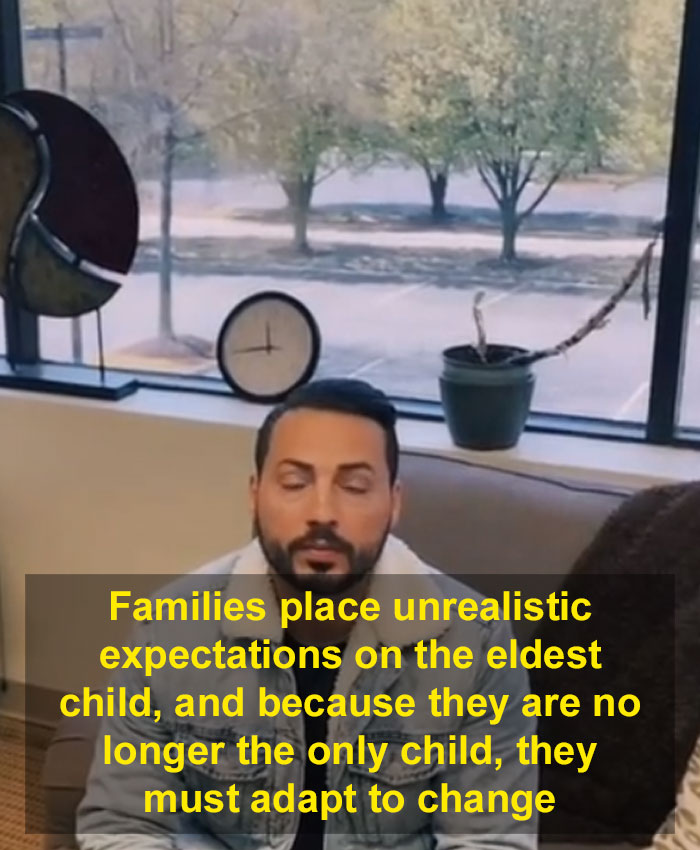

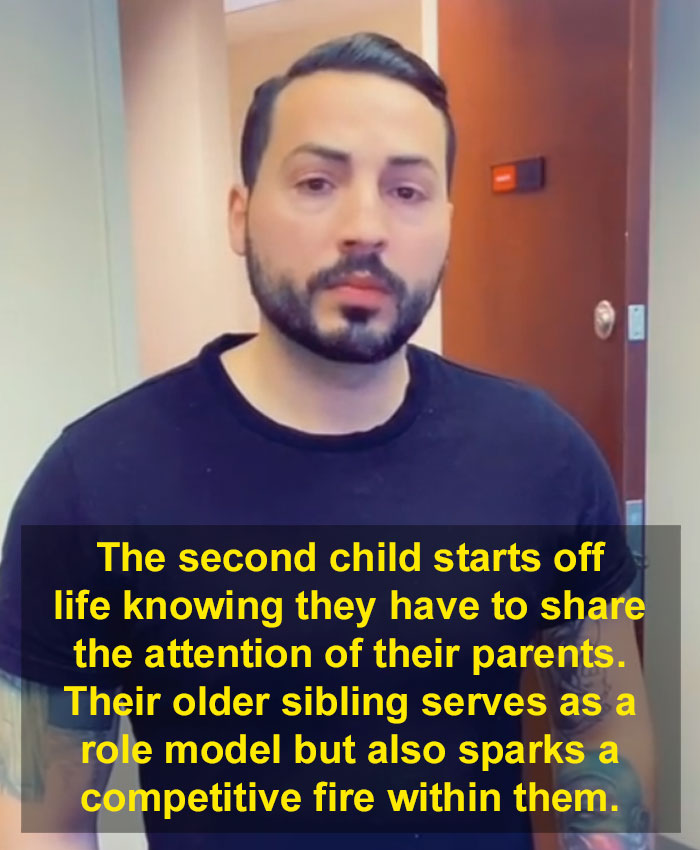


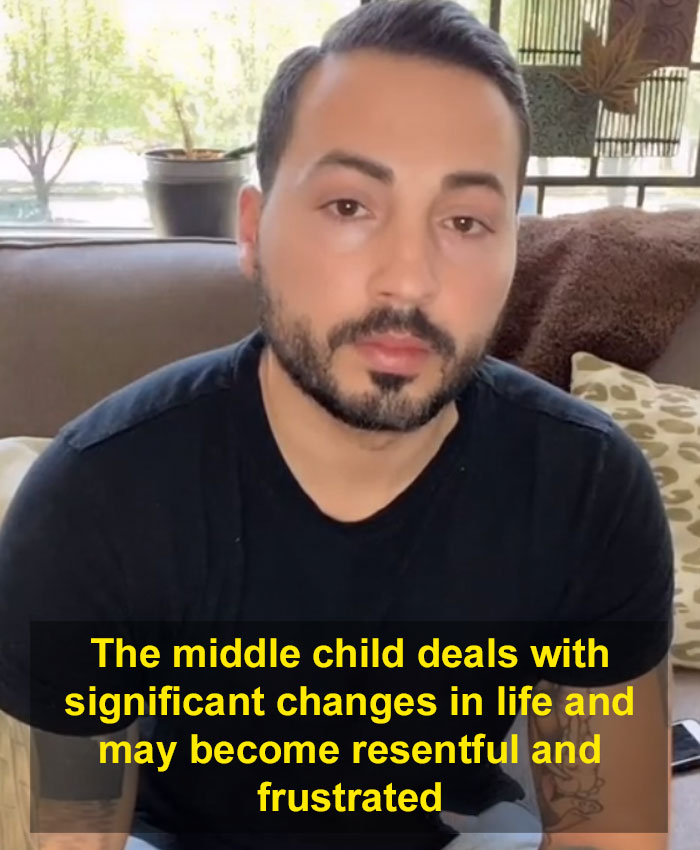
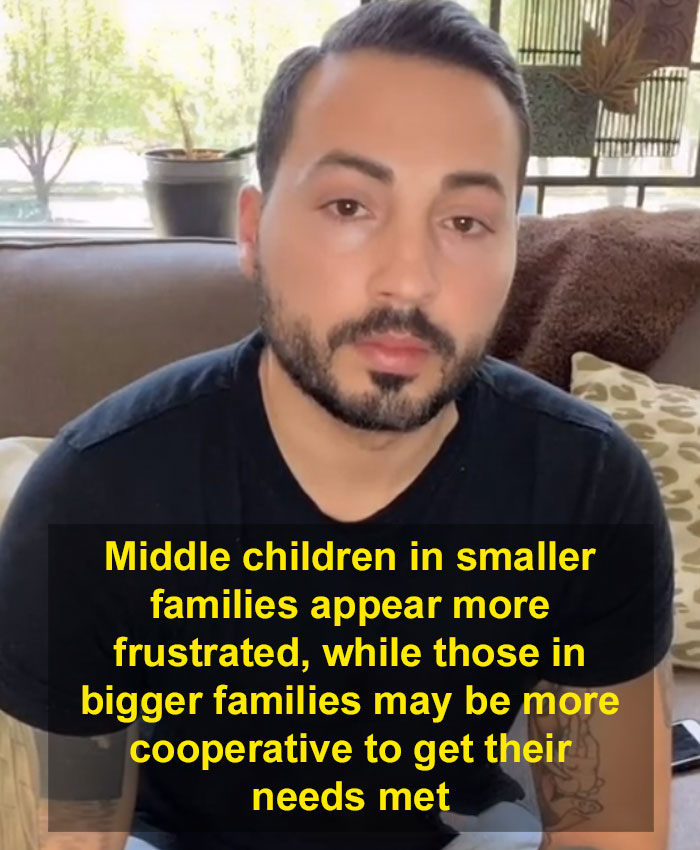
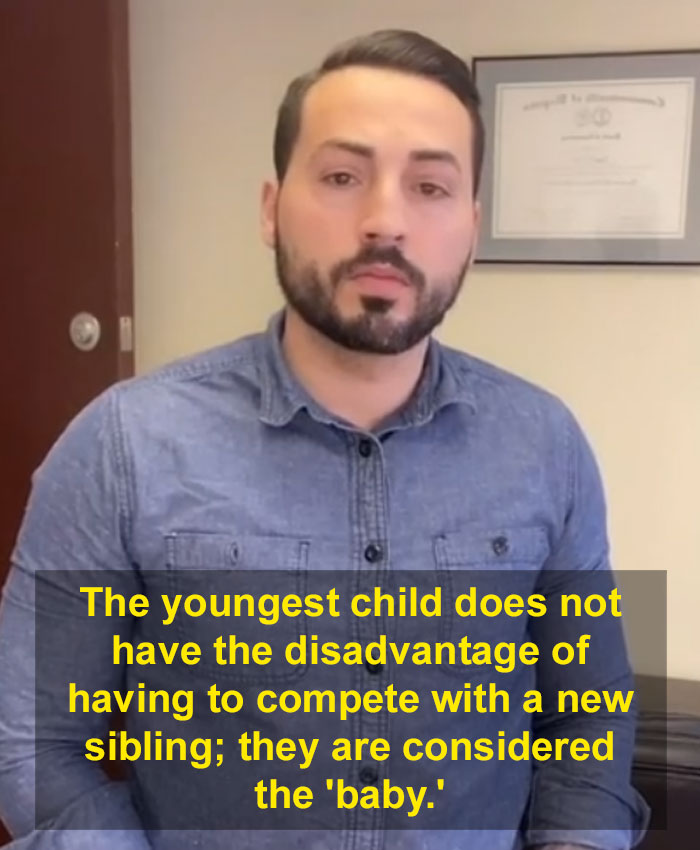
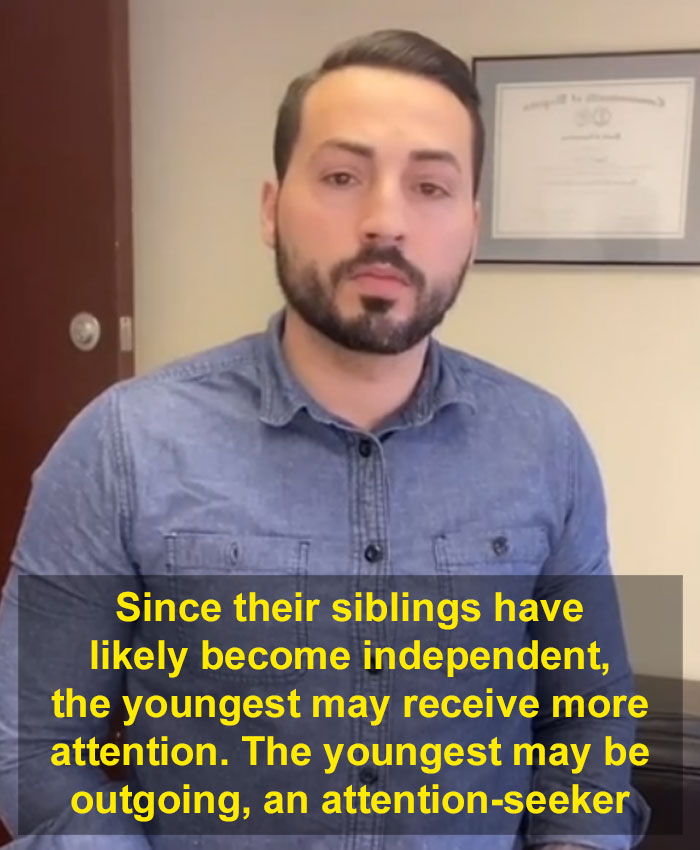
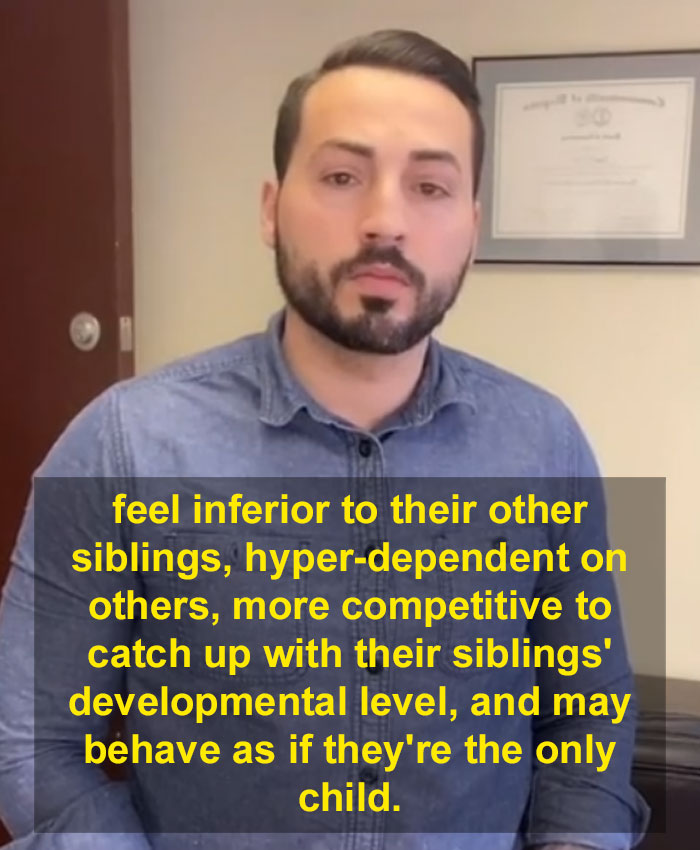
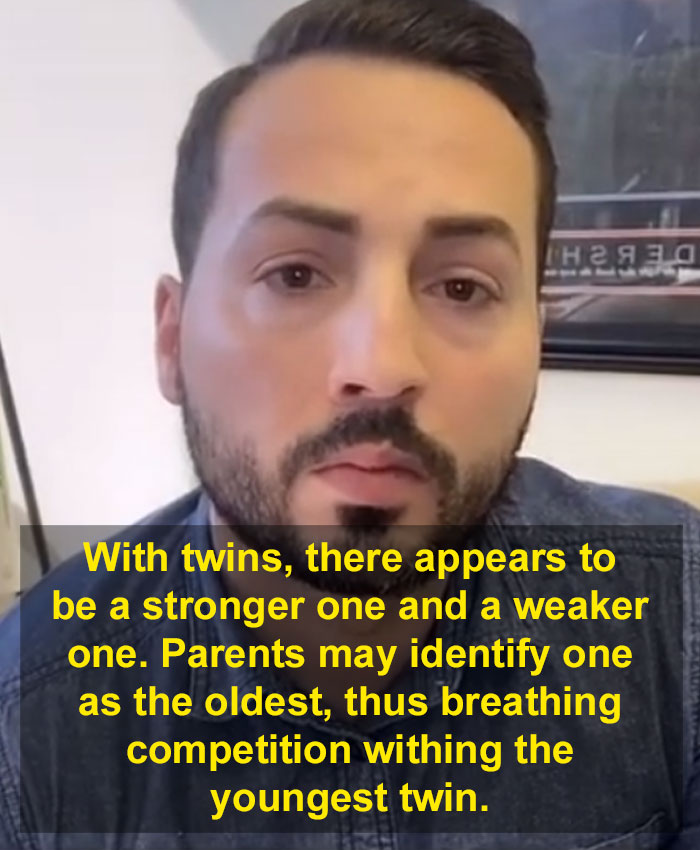


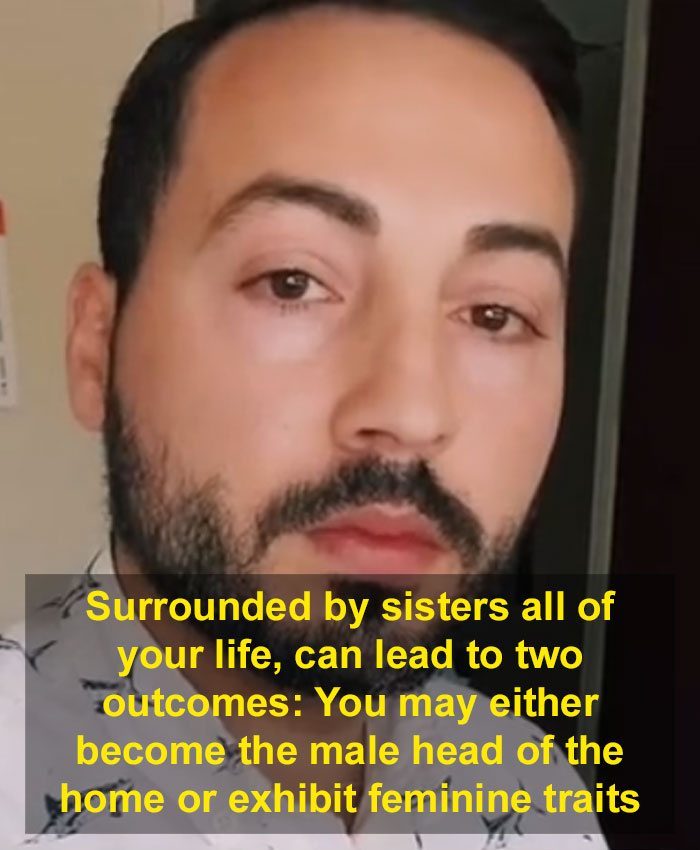














83
121